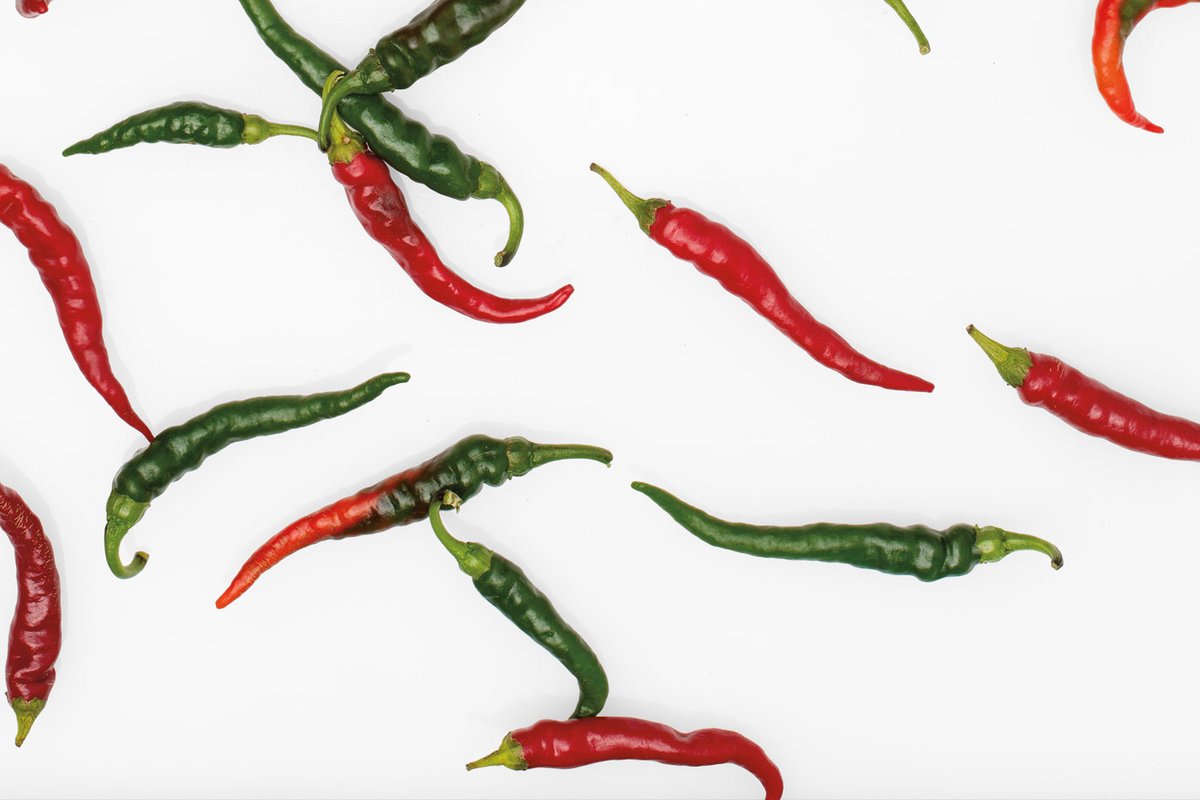
A Little Goes a Long Way
Cayenne peppers add flavor...and heat
Inside caves in the valley of Tehuacán, Mexico, archaeologists found evidence of wild peppers dating to 7000 B.C. These peppers were domesticated by Indigenous tribes 3,000 or 4,000 years later. Like many other products, peppers likely moved about the world on the ships of Portuguese, Spanish and Turkish traders.
Because the pepper arrived in Europe from multiple sources, many believed the plant came from India, and the confusion lasted for centuries. The English first mentioned peppers in the 16th century, referring to them as “Guinea” peppers, believing they came from the west coast of Africa.
According to Master of Historic Gardening Eve Otmar, Portuguese sailors took peppers out of Mesoamerica and, through trade, spread them all over the world, eventually making their way back to the Americas from Africa, via the slave trade. “Hence the tendency to believe they came from Africa,” noted Otmar.
The cayenne pepper is named for the capital city of French Guiana on the northern coast of South America, furthering its reputation for international origins.
Today cayenne peppers are grown in Colonial Williamsburg’s Sankofa Heritage Garden, a working display of the type of garden the enslaved might have tended for themselves in the 18th century. Such gardens were found on farms or plantations, and the owner would have had to give permission for his enslaved people to have a garden, Otmar said. She also pointed out that food was rationed, and enslaved people who grew some food of their own were better fed and therefore healthier.
The pepper was a popular ornamental plant in English gardens in the 18th century, and it slowly made its way into English cuisine. Hannah Glasse, in the 1755 edition of her popular cookbook The Art of Cookery, included “a little Cayan Pepper” in her recipe “To dress a Turtle, the West India Way.” She cautioned, “Take Care not to put too much.” As Richard Bradley in Dictionarium Botanicum (1728) observed, “’Tis very hot, so that a little of it goes a great way.” John Randolph mentioned the red pepper in his Treatise on Gardening (1793) only once, indicating that it was a mi-nor part of the Virginia diet.
Historic Foodways offers a recipe for a zesty vinegar made with cayenne pepper. The recipe, from Mary Randolph’s cookbook, is typical of the Southern cooking methods for which she was known. Randolph’s cookbook was the first to describe Southern dishes and ingredients such as cat-fish, turnip tops, okra, doughnuts — and vinegar flavored with cayenne pepper.
Pepper Vinegar
Historic Foodways
Adapted from The Virginia House-wife by Mary Randolph (Washington, D.C., 1824)
Yields 4 cups
Ingredients
- 12 cayenne peppers*
- 4 cups white vinegar
Instructions
- Cut the peppers in half and remove the stems and seeds. (Wear plastic or latex gloves for protection, especially with hotter peppers, and have plenty of ventilation.)
- In a saucepan, bring the peppers and vinegar to a boil and simmer for 15 minutes.
- Cool, strain out the peppers and bottle up the pepper vinegar.
- Use in preparations of sauces, soups and other foods or as a table condiment. No need to refrigerate but keep sealed.
*Adjust the exact amount and type of peppers as desired.
The Williamsburg Inn’s Executive Chef Julianne Gutierrez did not work with fresh cayenne peppers early in her career. But she does recall using what were known as “fish peppers,” grown by fisheries to make hot Cajun sauce before the widespread use of Old Bay Seasoning and other spicy mixes.
“When I worked in the Caribbean, we used hot sauces quite a bit,” said Gutierrez. Today she uses cayenne in a variety of ways — as a dredge for chicken, to add a kick to fried food and as a brine for chicken. “If you soak chicken overnight in a mixture of water, salt and hot sauce, it will pro-vide the flavor but not the heat to roasted chicken,” she said.
“If you want less heat in your dish, steer clear of the seeds,” she advised.
When purchasing fresh cayenne peppers, Gutierrez recommends being careful to select peppers with clean stems and no spots.
Gutierrez offers a complete meal: a cedar plank oven-roasted salmon with innovative Southern sides.
Cedar Plank Roasted Salmon with Cajun Cream Sauce, Succotash and Miso-Candied Collard Greens
Williamsburg Inn
Serves 6
Note: The collard greens take about 1 hour to prepare and cook. They can be prepared in advance and reheated with a splash of broth.
Salmon
Ingredients
- Food-grade cedar planks (enough to hold the 6 fillets)
- 6 salmon fillets, 6–8 ounces each
- Kosher salt and freshly ground black pepper
- Butter
Instructions
- Soak the cedar planks in water for at least 20 minutes.
- Preheat the oven to 350°F.
- Season the salmon generously with salt and pepper.
- Place the salmon on a hot grill briefly to mark the top side (optional).
- Place the salmon, skin side down, on the cedar planks and roast in the oven to an internal temperature of 130°F for medium doneness, 15–20 minutes.
- Top each fillet with a pat of butter and allow the fish to rest for 3–4 minutes.
- Top the fish with the Cajun Cream Sauce and serve with the Succotash and Miso-Candied Collard Greens.
Cajun Cream Sauce
Ingredients
- 1 tablespoon vegetable oil
- ½ medium yellow onion, minced
- 1 large shallot, minced
- 1 tablespoon minced garlic
- 1 rib celery, minced
- ¼ cup minced cayenne pepper (or other hot pepper)
- ¾ cup white wine
- 1 pint heavy cream
- Kosher salt and freshly ground black pepper to taste
Instructions
- In a saucepan over medium heat, heat the vegetable oil.
- Add the onion, shallot and garlic and sweat until translucent.
- Add the celery and peppers and cook until tender.
- Deglaze the pot with the white wine.
- Mix in the cream and allow the mixture to thicken.
- Season to taste with salt and pepper.
Succotash
Ingredients
- 2 tablespoons vegetable oil
- 1 onion, minced
- 2 cups lima beans
- 2 cups corn
- 1 red bell pepper, minced
- Kosher salt and freshly ground black pepper to taste
- Ground cayenne pepper to taste
- 1 pint cherry tomatoes, halved
- Butter
- 1 bunch parsley, stripped and chopped
Instructions
- In a sauté pan over medium heat, heat the vegetable oil.
- Add the onion and cook until translucent.
- Add the lima beans, corn and red bell pepper. Season with salt and pepper.
- Add a touch of cayenne pepper and cook until all the vegetables are tender.
- Add the cherry tomatoes and cook for another few minutes until warm.
- Finish with a knob of butter and garnish with fresh parsley.
Miso-Candied Collard Greens
Ingredients
- 1 teaspoon vegetable oil
- 3 yellow onions, sliced
- 1 tablespoon minced garlic
- 1¼ cups brown sugar
- ½ cup miso, white or yellow
- 1½ cups apple cider vinegar
- 1½ cups mushroom broth (vegetable broth may be substituted)
- 2 bunches collard greens, stems removed and torn into large pieces
- Kosher salt and freshly ground black pepper to taste
Instructions
- In a large frying pan over low heat, heat the oil and sauté the onions for a few minutes until golden brown. If needed, use a little water to lift any fond off the bottom of the pan.
- Add the garlic and cook a few minutes until aromatic.
- Add the brown sugar and miso, stirring continuously until they caramelize the onions, a few minutes.
- Mix in the vinegar and broth. Then add the collard greens.
- Cover and cook until the greens are tender, about 45 minutes. Remove the lid and cook until the liquid has reduced.
- Season with salt and pepper.
More from this Issue

